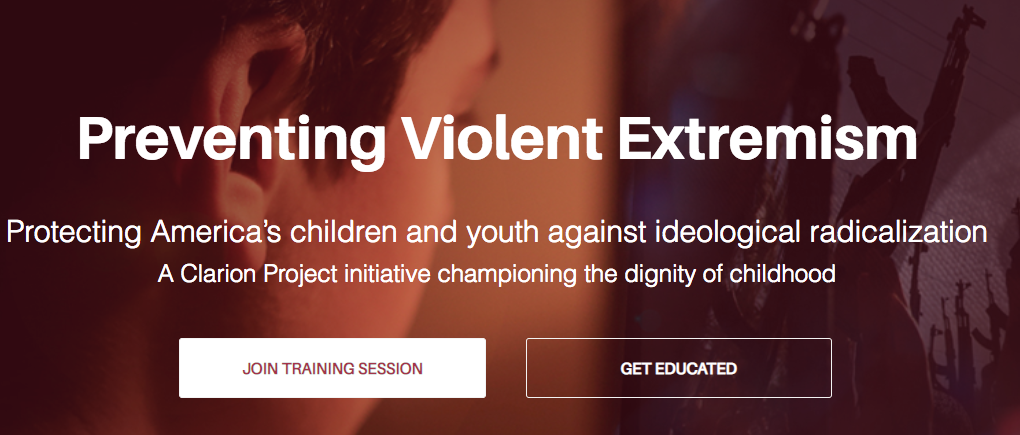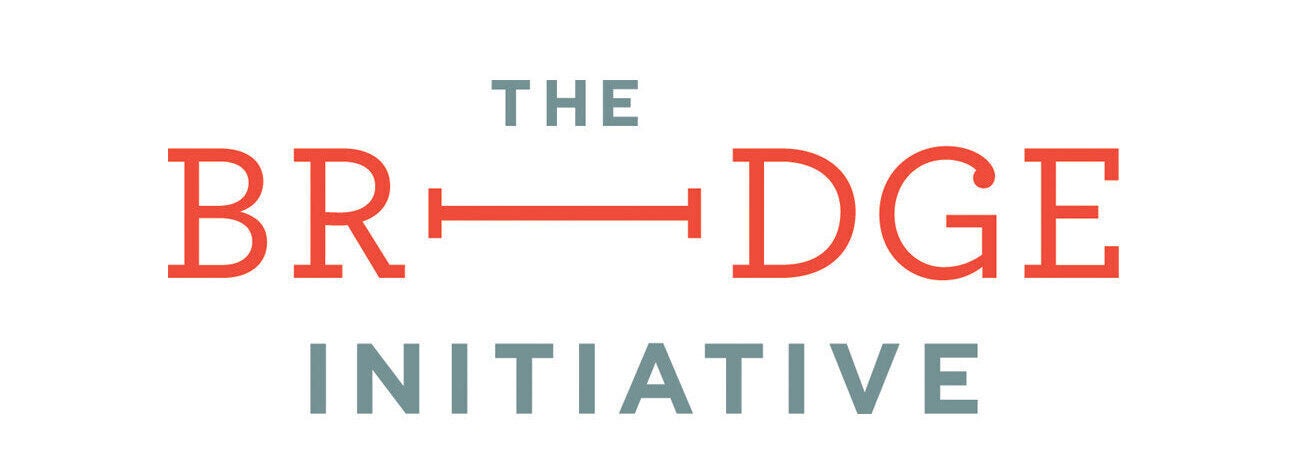
Credits: Clarion Project
The Clarion Project Has a “Preventing Violent Extremism” Program
On December 18, 2018, the Clarion Project, an organization with a long history of promoting anti-Muslim misinformation and conspiracy theories, published an article titled, “PVE vs CVE — What’s the Difference?” The piece, authored by Shireen Qudosi, who serves as the Clarion Project’s “National Correspondent,” purports to explain the difference between “Preventing Violent Extremism” (PVE) programs and “Countering Violent Extremism” (CVE) programs.
PVE and CVE are programs that various government agencies have employed to address “violent extremism.” As the New York University Law School’s policy institute the Brennan Center has demonstrated, both PVE and CVE are based on the belief that the root cause of “terrorism” is ideological and religious, not political.
Nonetheless, Qudosi tries to distinguish them by claiming that while PVE “looks to prevent radicalization from ever happening in the first place,” CVE “looks at the end of the conveyor belt to see how radicalized individuals can be redeemed, integrated and even activated in the fight against extremism.” Qudosi emphasizes that the “conveyor belt example is key.” To demonstrate the metaphor, Qudosi has embedded a clip from the “Chocolate Factory” episode of 1950s American sitcom I Love Lucy. Qudosi argues that the clip “perfectly illustrates Western CVE efforts.”
While Qudosi does not provide any citations or references (aside from the I Love Lucy clip), it is worth pointing out that the “conveyor belt” metaphor is not a stranger to counterterrorism studies and its attempts to explain “Islamic terrorism.”
Arun Kundnani, a professor at NYU who has written critically on the subject of “radicalization” and counterterrorism in both the UK and the U.S., argues that the “conveyor belt” model is a reductive and overly simplistic theory that posits that “once someone has adopted the extremist ideology, terrorism is likely to follow sooner or later.” In reality, there are a multitude of complex factors that lead to political violence, including repression and violence by the state. As Kundnani argues, “radical religious ideology does not correlate well with incidents of terrorist violence and . . . terrorism is best understood as the product of an interaction between state and non-state actors.”
Moreover, Faiza Patel of the Brennan Center has argued that the “religious conveyor belt” model “reinforces intelligence gathering that focuses on religious beliefs and behavior.” Patel explains that the model identifies “markers of radicalization” along each step of the way (i.e. “grievance or personal crisis to religiosity to the adoption of radical beliefs to terrorism”) that are “inextricably linked to Muslim religious behavior” and “identifiable to law enforcement officials who know how to recognize the signs.”
At the end of the article, Qudosi mentions that the Clarion Project is rolling out a Preventing Violent Extremism project of its own, which she describes as “a robust initiative that helps safeguard children from ever being put on the conveyor belt in the first place,” and as one that “starts with parents and educators gaining the tools they need to protect our children.”

Clarion describes the project goals as “protect[ing] the most vulnerable population — children and youth — from a sinister radicalization process.” Through workshops, Clarion will “deliver free information and training programs directly to your organization and community.” Namely, participants will learn about “the role of extreme ideology”; “push and pull factors that can either drive children to extremism or protect them from radicalization”; and “how to identify, listen, monitor and confront push factors.” Clarion’s PVE project landing page also has a section that offers “tips on how to spot signs of radicalization in young people with our articles, videos, podcasts, infographics and webinars.” Clarion bills the workshops as targeted to “parents, educators, social workers, counselors, local and state politicians, law enforcement and other members of the general public.”
It is important to note that there are no evidence-based signs or pathways to “radicalization,” as evidenced by CAGE, the Brennan Center, and the former U.N. Special Rapporteur on the promotion and protection of human rights and fundamental freedoms while countering terrorism, among others. Moreover, many of the so-called “indicators” of radicalization as conceptualized by the Federal Bureau of Investigation (FBI), the New York Police Department, (NYPD) the National CounterTerrorism Center (NCTC), and others, amount to constitutionally protected expressions of worship and speech, such as growing a beard, “frequent” attendance to services at a mosque, and criticism of U.S. foreign policy. “Signs of radicalization” also tend to rely on arbitrary notions of what is deemed “normal” behavior, such as “social alienation and anxiety,” “disaffection,” as well as “mental illness.”
Such “indicators” (reference chart published by the Brennan Center, page 15) have led to civil rights violations and blanket suspicion of Muslims in the U.S. by law enforcement. Moreover, the potential for even more violence and brutality by the state is rife. Take, for example, the 75 signs of “religious extremism” that the Chinese government currently uses to target Uyghur Muslims and increasingly other Muslim ethnic minorities in China. Such “signs” are employed as justification for extreme surveillance, infiltration, DNA collection, family separation, “reeducation,” detention and forced labor, torture, sexual violence, and death in concentration camps across Xinjiang, the autonomous region in northwest China where many Uyghur Muslims live.
The instructors listed for the workshops, whom Clarion offers to bring “to your city,” are Shireen Qudosi and Raheel Raza. Raza is also a member of the Clarion Project’s advisory board. It is unclear at this writing whether Clarion Project has yet conducted any workshops.
Based on their past statements, both Qudosi and Raza maintain that Islamic ideology is the core of the problem when it comes to “extremism.” Both have also advocated discriminatory treatment of Muslims, singling them out based on their faith identity and religious practices. In September 2016, for instance, Qudosi testified at a House Homeland Security Committee on “Identifying the Enemy: Radical Islamist Terror.” In her opening statement, Qudosi argued that “Islam is in desperate need of change in order to make peace with the values we expect from life in a 21st Century liberal democracy or free society.” In October 2014 on her online blog, Raza advocated the closure of “all mosques for three months to have intense scrutiny on the Imams and their sermons in the past 3 months” and a “moratorium on immigration from Muslim countries for a set period.” In Qudosi’s aforementioned congressional testimony, she recommended the “monitoring [of] fundamentalist mosques and communities” by law enforcement, and “restricting the ability of known, identified Islamists to immigrate” or even “Muslims who are likely of activating as radicals or Islamist.” Moreover, in February 2017, while a guest on The Blaze with Tomi Lahren, Qudosi said “either Islam needs to evolve or it needs to die.”
In addition, it is troubling that an organization like the Clarion Project is initiating a PVE project. The Center for American Progress (CAP) Fear Inc. reports list the Clarion Project as one the “main organizations fueling the Islamophobia network.” As detailed in the Bridge Initiative factsheet on the Clarion Project, some of Clarion’s main projects include daily articles and other web-based content about “radical Islam”; the production of anti-Muslim documentary films; and conspiratorial “investigations” into predominantly rural African-American Muslim communities. Indeed, Clarion Project’s raison d’etre is anti-Islamic. Despite this, its PVE program instructors both identify as Muslim, which serves to validate the project’s objectives and even insulate it from criticism. CAP has described such individuals as “validators” — a “group of individuals who claim inside knowledge about the realities of radical Islam” and “help buttress the extreme views of the Islamophobia misinformation experts, right-wing media enablers and anti-Muslim politicians.”
While the Trump Administration reportedly is not renewing the Department of Homeland Security (DHS) CVE grant program, CVE, unfortunately, isn’t going anywhere any time soon. CVE has become embedded into local law enforcement programs and social services, which was itself a directive of CVE under the Obama Administration. Moreover, federal programs outside of DHS, in addition to federally funded state–level and civil society programs, are ongoing. The same is true for U.S.-directed CVE programs internationally. The Clarion Project has added itself to this ever-expanding list of CVE programs in the U.S.

 Search
Search